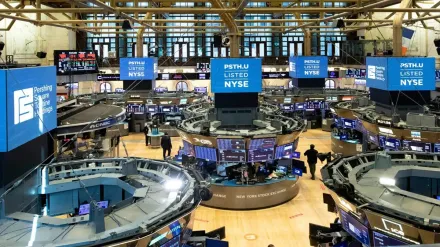The US stock markets witnessed a strong rebound on Tuesday, recovering from the steep declines seen on Monday’s sell-off. Investors seemed optimistic as equity futures turned green, signaling renewed confidence in the face of global economic uncertainty. This turnaround has sparked discussions about the volatility of the market and how investors are reacting to various macroeconomic factors that are influencing the market’s direction. While Monday’s drop caused concern among investors, the bounce back indicates that the US equity markets are showing resilience and have the potential to regain their footing despite challenges.
Monday’s Sell-Off: A Brief Recap
The US stock markets experienced a significant decline on Monday, with major indices like the Dow Jones Industrial Average, S&P 500, and Nasdaq Composite seeing losses that were fueled by multiple factors. Investors were rattled by mixed economic data, concerns over interest rate hikes by the Federal Reserve, and the ongoing volatility in global markets. The selling pressure was exacerbated by weak earnings reports from several key sectors, including technology, which led to a broader market pullback.
Investor sentiment was also influenced by inflationary concerns, with higher-than-expected inflation data in the previous weeks raising fears of persistent price pressures. This prompted many to worry that the Federal Reserve might be forced to implement more aggressive monetary tightening, which could potentially slow down economic growth and corporate profits.
However, despite these challenges, the market showed signs of stabilizing on Tuesday, with equity futures bouncing back, indicating that the worst may be over, at least for the time being.
The Rebound: What’s Driving the Market Recovery?
As the US markets opened on Tuesday, investors were quick to jump back into equities, with major stock indices showing positive movements throughout the day. Equity futures, which are contracts that indicate the direction of stock indices before markets open, turned green, signaling an early recovery from the Monday’s losses. The recovery was broad-based, with both large-cap and small-cap stocks participating in the rally. Several key factors contributed to this rebound:
Positive Earnings Reports:
- While some sectors had struggled with disappointing earnings, other companies posted better-than-expected results, which helped improve investor sentiment. Strong earnings from the consumer goods and healthcare sectors provided a much-needed boost to the market, proving that some areas of the economy were still thriving despite broader challenges.
Stable Economic Data:
- A release of economic data on Tuesday showed that consumer sentiment had not deteriorated as much as feared, and job growth remained relatively strong. These indicators reassured investors that the economy was not on the brink of recession, giving rise to hopes of a more moderate path for interest rate hikes. Stability in economic data helped mitigate some of the anxiety surrounding a potential economic slowdown.
Lower Treasury Yields:
- Treasury yields, particularly the benchmark 10-year yield, fell back after rising sharply in the previous weeks. This decline in bond yields helped ease concerns about the impact of rising rates on corporate borrowing costs and consumer spending. When yields fall, stocks become more attractive as an alternative investment, prompting buyers to return to the equity markets.
Global Factors and Geopolitical Stability:
- Global factors also played a role in the market rebound. The market was calmed by signs of geopolitical stability, with some tensions in Europe and Asia beginning to ease. Additionally, the Chinese government’s efforts to stimulate economic growth by providing fiscal support helped lift investor optimism. As a major global economic player, China’s policy decisions have a ripple effect on US markets, especially in sectors like technology and commodities.
Market Sentiment and Investor Behavior:
- Market sentiment plays a significant role in stock market movements, and the strong rebound on Tuesday was partly driven by investor psychology. After the significant losses on Monday, many investors saw the market sell-off as an opportunity to buy stocks at lower prices. This buying activity, combined with a return of risk appetite, fueled the rally in equity markets. The resilience of US markets also reflects investors’ confidence in the long-term growth potential of the economy, despite short-term volatility.



What’s Next for the US Stock Markets?
While the recovery on Tuesday was encouraging, many market experts caution that the outlook for US equities remains uncertain. The global economy is still navigating significant challenges, including rising inflation, supply chain disruptions, and potential geopolitical risks. The Federal Reserve’s actions will continue to be closely monitored, as investors assess whether the central bank will take a more aggressive stance on tightening monetary policy in response to persistent inflation pressures.
Additionally, earnings season will remain a critical focal point for the markets. The results of key companies in sectors such as technology, finance, and consumer goods will provide further insight into the health of the economy and corporate earnings growth. A series of disappointing earnings could weigh on the markets, while positive surprises may continue to support the rally.
Inflation concerns also remain top of mind for investors. While the latest economic data may have offered some relief, it’s clear that inflation is still a challenge. Rising costs for consumers and businesses could weigh on profits, and sustained inflation could ultimately lead to more restrictive monetary policies from the Federal Reserve. Therefore, the trajectory of inflation will likely be a key driver for US stock markets in the months to come.
Conclusion
The US stock markets showed a remarkable recovery on Tuesday after a sharp sell-off on Monday, with equity futures turning green and investor sentiment improving. While the markets are still navigating a host of economic challenges, including inflationary pressures and rising interest rates, the rebound demonstrates the resilience of US equities. As investors focus on upcoming economic data, corporate earnings, and the Federal Reserve’s policy decisions, it is likely that the market will continue to experience volatility in the short term. However, the positive movement on Tuesday offers hope that the markets can adapt to these challenges and continue to recover in the face of uncertainty.
FOLLOW:https://newsroom47.com/roshni-nadar-malhotra-empowering-change/
Newsroom 47
